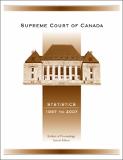|
Reseña:
|
This special edition of the Bulletin sets out a statistical view of the work of the Supreme Court of Canada in 2007 with comparisons to the previous ten years’ work.The following brief description of the appeal process is provided to help explain the statistical charts and tables. The Court decides cases that come to it from three sources. First, in most cases, a party who wishes to appeal the decision of another court (usually a provincial or territorial court of appeal or the Federal Court of Appeal) must obtain permission from a panel of three judges of the Court. Such permission, or leave to appeal, is given if the panel concludes that the case involves a question of public importance or raises an important issue of law. Second, there are cases, referred to as “as of right” appeals, for which leave to appeal is not required. These include certain serious criminal cases, for example, those where there is a dissent on a point of law in the court of appeal, and appeals from provincial references. The third group is references from the federal government. Federal references (which are counted as appeals as of right for the purposes of these statistics) require the Court to give an opinion on the questions referred to it by the Governor in Council. The figure on page 3 summarizes the process that unfolds from the filing of a complete application for leave to appeal, a notice of appeal as of right or a reference. |

